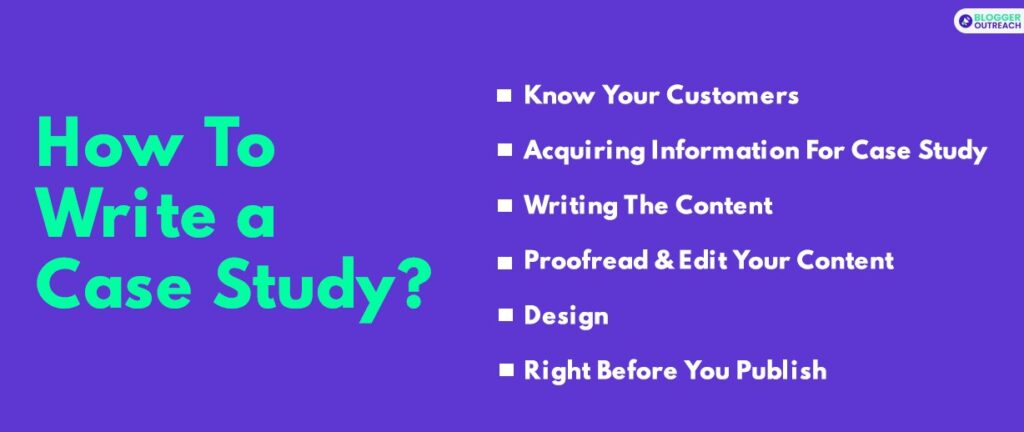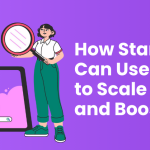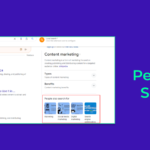Table Of Content
- 1 What Is A Case Study?
- 2 Who Needs Case Studies?
- 3 How To Write A Case Study?
- 4 10 Professional Case Study Examples
- 4.1 1. Optimizely – Collaboration With Google Analytics and
- 4.2 2. Royal Bank Of Scotland – Adobe
- 4.3 3. LeadGnome Worked With Host Analytics
- 4.4 4. The Line Leveraged Tabola
- 4.5 5. Stanley Got Tremendous Result With BrightEdge
- 4.6 6. Lane Bryant Got Amazing Results With OutBrain
- 4.7 7. Weed Man Collaborated With Five9
- 4.8 8. Red Hat: North Carolina State Websites
- 4.9 9. HubSpot Capitalizes LinkedIn Feed
- 4.10 10. Rackspace Chooses Life Size
- 5 Final Takeaway – The Best Format
Do you want to craft a fascinating case study to capture your reader’s attention and present your product or service in the most favourable light?
Writing a successful case study is no piece of the cake. It requires careful research, planning, and strict attention to facts and figures.
A quick Google search for “case studies” reveals the truth: case studies mean something different to each industry.
You can employ case studies in the marketing realm, but the question is – why and how their use varies greatly in the business sphere.
However, how can you create a case study that makes sense to your audience?
Writing a case study seems difficult for you at first!
Fortunately, several excellent case study samples can help you along the way.
This article aims to provide a comprehensive idea of a case study and share 10 exemplary case studies to draw references.
What Is A Case Study?

A case study is an analysis of marketing strategies, tools, and tactics. A study shows measurable outcomes like:
- Sales
- ROI
- Traffic, etc
Simply put, it is a story-like narrative that follows a customer’s journey.
Through this story, you can showcase how they overcame their challenges by using your products or services.
Spotlight your product or service’s great results for customers in a case study.
This can help you generate more business and close more deals.
Showing off how your product or service has delivered impressive results is an excellent way to capture the attention of potential customers.
Who Needs Case Studies?
Let’s kick off by reviewing the basics.
You can utilize case studies to help sell products or services if you’re running a business.
This can include showcasing a certain item or feature and the outcomes it can bring your future customers.
For example, let’s say you’re a fitness consultant. You might conduct a case study of your clients. Let’s say you name it as ‘Mr. X reduced 32 kgs in 4 months. Here you can showcase the initial challenges faced by your client and how your services helped them to attain their fitness goals.
Similarly, if you are from any service demanding results, prepare a case study.
When your audience goes through a real-world example, they experience validated outcomes. This brings faith to your marketing materials – your product does just what it says it will.
How To Write A Case Study?

Don’t just randomly start writing a case study. It is a process-driven approach that requires undivided attention to minute details.
1. Know Your Customers
A case study is an indirect way to impress and convince your prospects who can make a purchase decision with your brand.
Ask These Three Questions Yourself:
- What are the pain points of your prospects that you can solve?
- What industry do they belong to?
- Who makes the buying decisions?
Now, consider closely examining your happy customers and representing them in a way that resonates with your prospects.
However, you might think, “What if I have more than one buyer’s persona?”
Worry no more! This is a common trait of B2B industries because your buyers consist of a group of people. It would help if you considered creating a buyer’s persona for each key member.
To Add Up Further, Here Are The Ways You Can Choose The Right Customer For Your Case Study:
- Analyze the results they got, and if they are remarkable and worth sharing, feature them.
- Check if your customers come from your competitor.
- Whether your brand positioning is aligning with your customers.
- What are the products and services that your customers use?
Once you’ve decided whom you will feature in your case study, it’s time to start collecting the information.
2. Acquiring Information For Case Study
The most common way to gather information for your case study is by conducting an interview. Step up, reach out to your customers, and convince them to participate in an interview.
(i) Preparation
The first step for executing a case interview is preparing your customers for the case study. Preparation saves time as here they already know the right way of sharing their information. Once you prepare them for the elementary question, think of a more crucial question – what’s stopping them from making a purchase?
(ii) Format
We recommend people represent a case study in the form of a story as that connects the reader’s emotions.
- Start your article by tapping into the pain issues of your audience.
- Next, the middle of the case study should cover the customer’s experience of working with you.
- At the end of the case study, you should think about portraying yourself as the hero of the story.
(iii) Questions
Here is the question that you can ask-
- What was the initial challenge you faced before coming to us?
- Ask them about the ‘eureka moment’ when they realized they needed to come up with solutions for their challenges.
- What makes them opt for you?
- How long did they wait to realize the results?
- What do they think of our solutions? Does that exceed your expectations?
- How is your overall experience working with us?
(iv) Conducting The Interview
Now that you’ve got your questions ready and a faithful customer willing to answer them, all that’s left is to conduct your case study interview.
This is your chance to get the details you need to craft an amazing story. Then, with the responses you’ve obtained, all that’s left to do is structure them into an engaging and captivating narrative.
Here Are The Ways To Begin Your Interview-
- Emails
- Face-To-Face Interviews
- Emails
- Over The Phone
(v) Points To Remember
- Build rapport before conducting the interview and make them feel comfortable.
- You need a script, but that doesn’t mean you can’t go off-script and conduct it in a seamless manner.
- It may sound silly but don’t forget to record your interview. Ask for the customer’s consent and record it for further reference.
3. Writing The Content
Here comes the most important step!
Discover how to write an impactful case study that gets results! We’ll walk you through what makes a compelling case study, from the headline to the conclusion.
(i) Attention-Grabbing Headline: A headline reflects the crux of your content and entices people to read further.
(ii) Subtitle: Include a subtitle with supporting details or a custom quote to enhance the headline.
(iii) Overview: Provide an overview of the client’s name/industry, product/service used, and result in stats at the top.
(iv) Introduction: Introduce the customer by highlighting an interesting detail about them.
(v) Problem: Describe the challenge faced by the customer, the consequences, and their hesitation.
(vi) Solution: Explain how the customer found you, why they chose you, what solution they chose, and how you can implement it.
(vii) Results: Showcase the solution’s results and benefits, plus any bonus benefits.
(viii) Conclusion: Include additional praise from the customer and words of advice for other businesses like them.
4. Proofread & Edit Your Content
You must revise and edit your content before publishing it.
Let’s say you’re cooking your favourite recipe, and it seems something is missing. You quickly realize that it requires a bit more spices. You add them and make them tasty. Sorry, but we can’t draw more relevant references for you.
Proofreading and Editing add the final touch to your content, and this is something that separates excellent case studies from average case studies.
(i) Editing
You can perform extensive editing with the help of feedback. Getting feedback requires two approaches – internal feedback and customer feedback.
(ii) Internal Feedback
Internal feedback is all about self-introspection. It reflects what you and your team things about the case study.
If you have a team, ask them what they think about it. Is it done the way you and your team thought about it?
The smartest thing would be to get feedback from people who play a crucial role in customer handling.
This is because those in charge of customer support know the ins and outs. Getting feedback from them helps you create a case study that easily resonates with your customers and prospects.
(iii) Customer Feedback
From the standpoint of your customers, they must feel valued and included. Getting customer feedback is also an indirect way of seeking your customers’ consent. While checking the case study, they will tell you if they think they are uncomfortable about sharing any specific details.
(iv) Proofreading
To provide a professional look and feel, you must refrain from making typos and grammatical errors. If you share statistical figures and facts, ensure you add the most recent and relevant ones.
5. Design
If you’re leveraging a video testimonial, create an engaging video by adding visual appeal to it. But you must consider the following design practices to represent it in a static post.
- Colour: Don’t put something random. You should select a colour that aligns with your brand colour. Because when you publish more case studies, a consistent colour template will help you to stay on top of the mind.
- Add Visual Elements To Make It Scannable: Visual elements such as charts, infographics, and guides grab your audience’s attention and make your information easily scannable.
- Readability: No one likes a wall of text! Make your case study easier to read by breaking it down into sections and shorter paragraphs. Use plenty of white space to make it look inviting. Use simple, conversational language to make reading enjoyable.
6. Right Before You Publish
Even if you’re fully confident with your content and design, we recommend you proofread the content and check the design again.
Your case study is crucial for customers who are considering your brand for future purchases. So why not give it time and make it perfect?
Just before you publish, give it a quick check!
Now you’re ready to publish. Once you are done publishing your content, send it to your customer and thank them for their cooperation.
10 Professional Case Study Examples
As of now, you got an idea about the important components of a case study. Let’s learn it in a practical manner.
1. Optimizely – Collaboration With Google Analytics and
Who? Based out of San Fransico, California, Optimizely is an A/B testing and experience optimization platform that provide data-driven marketing solution for its clients.
Problem: The challenge was identifying the page views in a more efficient way to gauge where customers are in the buying journey.
Result: With the help of Google Analytics’s premium data, they helped Optimizely to nurture the leads throughout the sales funnel.
Case Study Link: https://bit.ly/444vgTr
2. Royal Bank Of Scotland – Adobe
Who? Specialized in modern banking, outstanding service, and inventive marketing transformation, The Royal Bank of Scotland is known for its robust presence.
Problem: They wanted to streamline the process that enables them to make data-driven decisions and deliver seamless digital experiences.
Result: They witnessed a 20% increase in conversion, as well as an increase in internal communication,
Case Study Link: https://bit.ly/3NSb6VZ
3. LeadGnome Worked With Host Analytics
Who? Host Analytics is cloud-based enterprise performance management offering a range of financial applications for modelling, planning, consolidation, modelling, and reporting.
Problem: They were not getting quality leads for their business.
Result: LeadGnome leveraged email marketing automation for them that helped them in garnering quality leads for their business.
Case Study Link: https://bit.ly/3CWuM5T
4. The Line Leveraged Tabola
Who? Known for its unique experience, the Line is an online boutique that displays products you can get at its brick-and-mortar store.
Problem: It took a lot of work to attract first-time visitors to their site.
Result: Within three months of working with Taboola, the Line witnessed a 12% growth in email subscribers and 72 million impressions.
Case Study Link: https://bit.ly/3O49ytj
5. Stanley Got Tremendous Result With BrightEdge
Who? In 2015, Stanley merged two distinct brand web properties into one site. The process had to reduce traffic disruption, boost traffic, and enhance organic search results.
Problem: They need to generate more organic traffic, organic revenue, total keyword presence in search engine pages, and full pages indexed by a search engine.
Result: With the help of the BrightEdge platform, they boosted their traffic immensely, and almost 40% of the keywords ranked for the first page.
Case Study Link: https://bit.ly/446f6J7
6. Lane Bryant Got Amazing Results With OutBrain
Who? Lane Bryant is igniting a movement to redefine the traditional notion of sexy and celebrate all women with a campaign designed to inspire and engage – because ALL women are sexy.
Problem: The aim was to increase social virality and make it more engaging.
Result: OutBrain used media amplification to skyrocket the campaign’s reach, resulting in a staggering 48,500,000 impressions in only two weeks! Additionally, they got 6700 page views, a 238% increase in CTR.
Case Study Link: https://bit.ly/46uqEr5
7. Weed Man Collaborated With Five9
Who? Specializing in lawn care, Wee Man has been in the business for more than 40 years.
Problem: Quoting Weedman, “If their phone-based reps could connect with more prospects, more decisions would result, without adding sales reps.”
Result: Weed Man took the plunge and migrated their data to the cloud with the help of Five9.
Case Study Link: https://bit.ly/46sgDec
8. Red Hat: North Carolina State Websites
Who? North Carolina Department of Information and Technology.
Problem: To abide by the governor’s mandate, the North Carolina Department of Information and Technology needed to overcome the complex process to make the website seamless.
Result: Red Hat’s solution helped them reduce maintenance time and cost.
Case Study Link: https://bit.ly/44mDUMK
9. HubSpot Capitalizes LinkedIn Feed
Who? HubSpot is one the pioneers of inbound marketing, sales, and customer service.
Problems: HubSpot wanted to target small and medium-sized businesses by targeting them with ebooks, how-to guides, webinars, etc.
Results: Efforts on this platform generated incredible 400% more leads within their target audience than other platforms!
Case Study Link: https://bit.ly/3Xyv24v
10. Rackspace Chooses Life Size
Who? Rackspace is a global leader in hybrid cloud computing, boasting offices all over the world. The challenge was to collaborate and communicate across offices in an exciting way.
Problems: Rackspace sought to connect remote offices across different time zones and required a communication ecosystem that could enable face-to-face interactions.
Results: Life Size developed a video solution to help pave the way for stronger connections between international offices.
Case Study Link: https://bit.ly/46reLCu
Final Takeaway – The Best Format
We hope that we can educate you throughout this article. If you plan to build a portfolio, this article will be your reference point.
But you might be thinking about the correct format to represent the data.
Here’s Something That You Can Follow:
- Context – setting the stage for the situation.
- Challenge – delving into the key problem the customer was facing.
- Solution – introducing the product/service that solved the problem.
- Benefit – highlighting the advantages of the solution.
- Result – the impressive business outcome from the solution.
Now you got everything that is needed to write a perfect.
We expect that there won’t be any major questions after you read this article. But if you have any, feel free to reach out to us.
Read Also:








